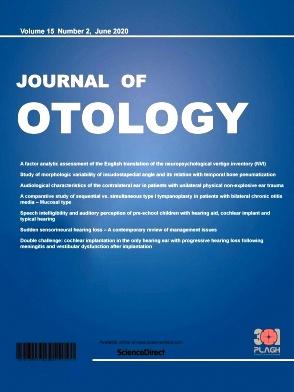Investigating Additional Cochlear Parameters: A follow-up systematic review and meta-analysis
IF 1.4
Q2 OTORHINOLARYNGOLOGY
引用次数: 0
Abstract
Objectives
The movement towards personalization of cochlear implantation has continued to generate interest about variabilities in cochlear size. In a recent meta-analysis, Atalay et al. (2022) examined organ of corti length, cochlear lateral wall, and “A” value and found that most covariates, other than congenital sensorineural hearing loss, did not impact cochlear size via these measurements. However, no meta-analysis exists on how patient-specific variables could impact other cochlear size measurements, such as cochlear height (CH), and “B” value (defined as the distance between opposite lateral walls and perpendicular to “A” value). The purpose of this systematic review and meta-analysis is to examine how patient-specific variables impact additional cochlear size measurements to assist clinical decision-making.
Databases reviewed
A systematic review for cochlear size measurements using PRISMA methodology was performed using PubMed, CINAHL, and MEDLINE from database inception to October 1st, 2022.
Methods
Search terms used included English, cochlea, size, histology, anatomy, and human. Inclusion criteria were measurements for human cochlea, full-text articles, and articles in English. Primary measurements were “B” value and CH, as these measurements differ from the recent meta-analysis on this topic. Cochlear duct length (CDL) was also included. A random-effects continuous model for meta-analysis was performed. Measurements were stratified by gender (male/female) and disease type (sensorineural hearing loss (SNHL)/conductive hearing loss (CHL)).
Results
A total of 7 articles met final inclusion criteria from a total of 674 articles received on initial search, resulting in 2263 total human cochleae. There was a statistical difference between male CDL (n = 681 cochlea) compared to female CDL (n = 657) from four articles (p < 0.001; Cohen's d effect size (ES):0.421; 95% confidence intervals (CI): 0.171, 0.671). The frequency weighted mean for male CDL was 33.5 mm ± 1.8 mm and the frequency weighted mean for female CDL was 32.4 mm ± 1.5 mm with an unstandardized mean difference of 0.854 mm. There was no statistical difference between male “B” value (n = 329) and female “B” value (n = 349) for cochlea from two studies (p = 0.184; Cohen's d ES: 0.410; 95% CI: 0.194, 1.014). The frequency weighted mean for male “B” value was 6.5 mm ± 0.1 mm and the frequency weighted mean for female “B” value was 6.4 mm ± 0.1 mm with an unstandardized mean difference of 0.126 mm. There was no statistical difference between CH for SNHL (n = 282) and CHL (n = 275) from two studies (p = 0.486; ES: 0.085; 95% CI: 0.323, 0.153, F ig. 3). The frequency weighted mean for SNHL CH was 4.6 mm ± 0.8 mm and the frequency weighted mean for CHL CH was 4.3 mm ± 0.8 mm with an unstandardized mean difference of 0.032 mm.
Conclusion
Male CDL is statistically larger than female CDL. There is no statistically significant association between gender or hearing loss type and “B” value or CH. The effect size for all comparisons is small, indicating little practical significance between any existing differences. The results of this study provide two additional cochlear metrics and indicate similar findings to the study by Atalay and colleagues as patient-specific characteristics appear to have no statistically significantly impact on cochlear size.
调查其他耳蜗参数:随访系统回顾和荟萃分析。
目的:人工耳蜗植入术个性化的发展不断引起人们对人工耳蜗大小变异的兴趣。在最近的一项meta分析中,Atalay等人(2022)检查了器官的corti长度、耳蜗侧壁和“a”值,发现除了先天性感音神经性听力损失外,大多数协变量通过这些测量并不影响耳蜗大小。然而,对于患者特异性变量如何影响其他耳蜗尺寸测量,如耳蜗高度(CH)和“B”值(定义为相对侧壁和垂直于“A”值之间的距离),尚无meta分析。本系统综述和荟萃分析的目的是研究患者特异性变量如何影响额外的耳蜗尺寸测量以辅助临床决策。数据库回顾:使用PubMed, CINAHL和MEDLINE对从数据库建立到2022年10月1日使用PRISMA方法进行耳蜗尺寸测量的系统回顾。方法:使用的检索词包括英语、耳蜗、大小、组织学、解剖学和人类。纳入标准为人耳蜗测量、全文文章和英文文章。主要测量值为“B”值和CH,因为这些测量值与最近关于该主题的荟萃分析不同。耳蜗管长度(CDL)也包括在内。采用随机效应连续模型进行meta分析。测量结果按性别(男/女)和疾病类型(感音神经性听力损失(SNHL)/传导性听力损失(CHL))分层。结果:初始检索共收到674篇文献,其中7篇符合最终纳入标准,共计2263篇人耳蜗。男性CDL (n = 681)与女性CDL (n = 657)有统计学差异(p)结论:男性CDL比女性CDL有统计学意义。性别或听力损失类型与“B”值或CH之间没有统计学上的显著相关性。所有比较的效应量都很小,表明存在差异的实际意义不大。这项研究的结果提供了两个额外的耳蜗指标,并表明与Atalay及其同事的研究结果相似,因为患者特异性特征似乎对耳蜗大小没有统计学上显著的影响。
本文章由计算机程序翻译,如有差异,请以英文原文为准。
求助全文
约1分钟内获得全文
求助全文
来源期刊

Journal of Otology
Medicine-Otorhinolaryngology
CiteScore
2.70
自引率
0.00%
发文量
461
审稿时长
18 days
期刊介绍:
Journal of Otology is an open access, peer-reviewed journal that publishes research findings from disciplines related to both clinical and basic science aspects of auditory and vestibular system and diseases of the ear. This journal welcomes submissions describing original experimental research that may improve our understanding of the mechanisms underlying problems of basic or clinical significance and treatment of patients with disorders of the auditory and vestibular systems. In addition to original papers the journal also offers invited review articles on current topics written by leading experts in the field. The journal is of primary importance for all scientists and practitioners interested in audiology, otology and neurotology, auditory neurosciences and related disciplines. Journal of Otology welcomes contributions from scholars in all countries and regions across the world.
 求助内容:
求助内容: 应助结果提醒方式:
应助结果提醒方式:


